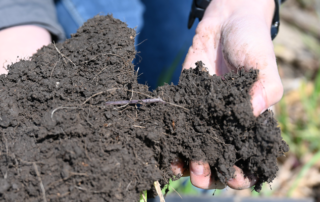Suspect Red Crown Rot in Your Soybeans? Get a Free Diagnosis Now.
Researchers are on the lookout for Red Crown Rot (RCR) across Illinois. If you suspect RCR in your fields, send your diseased samples to the USDA-ARS lab in Urbana for free. Help us monitor and identify new areas in Illinois where this pathogen has spread.
Understanding the Crop Injury Risks of PRE Herbicides in Early-Planted Soybeans
As farmers continue to plant soybeans earlier, there are concerns about preemergence (PRE) herbicide injury to emerging seedlings. Supported by the Illinois Soybean Association, the University of Illinois Crop Sciences department is evaluating different PRE herbicides on early-planted soybeans to give farmers access to crop injury ratings for better weed management decisions.
Which Insect Pests and Diseases Cause the Most Damage to Soybean Stems in Illinois?
Researchers collected over 200 diseased stems from 59 counties in Illinois between 2022 and 2023 to address gaps in understanding soybean stem pests and diseases. Based on this data, Dr. Nick Seiter highlights the significance of dectes stem borer in no-till fields in south-central Illinois, while Dr. Jason Bond discusses prevalent diseases such as fusarium, stem-canker, and charcoal rot across various counties, offering management strategies to combat these issues.
Soybean Phytophthora Stem and Root Rot Resistance Genes Have Become Less Effective
Managing soybean Phytophthora stem and root rot starts with variety resistance. A recent study led by Michigan State University determined that previously relied upon resistance genes are failing and there is a need for soybean breeders to incorporate new sources of resistance.
How Can the Profitability of Double Crop Wheat and Soybeans Be Improved?
Double crop soybeans after winter wheat can enhance profitability and soil health in the Midwest, but success depends on identifying early-maturing winter wheat varieties to optimize soybean planting conditions. This Illinois Soybean Association-funded project aims to identify high-yielding winter wheat varieties that can be harvested earlier and allow earlier planting of double-crop soybeans to maximize soybean yield potential.
How Widespread is Group 15 Herbicide Resistance in Illinois Waterhemp Populations?
Illinois soybean farmers face a major challenge as waterhemp weeds have developed resistance to multiple herbicides, including Group 15 herbicides confirmed in 2019. A project funded by the Illinois Soybean Association and led by the University of Illinois Urbana-Champaign aims to evaluate the prevalence of this resistance and provide farmers with management recommendations.
Contributors Needed for Weed Mapping Project
Scientists are working to track troublesome weeds across the country by creating and updating weed distribution maps. They are seeking help from crop consultants, agronomists, and weed scientists for this project.
Wet Spring Weather and Nitrogen Loss Revisited
With May's rainfall continuing following a wetter-than-usual April, concerns regarding nitrogen (N) losses are on the rise. In this farmdoc article, Giovani Preza Fontes and Emerson Nafziger talk about the concern of how much N will be available for the 2024 corn crop and determining the optimal timing for additional N application.
Can Henbit Serve As A Host Away from Soybean?
Illinois Soybean Association Outreach Agronomist, Stephanie Porter, CCA, shares the challenges of winter annual weeds, highlighting henbit and purple deadnettle as alternative hosts of soybean cyst nematode. Research suggests that managing winter annuals in the fall, applying residual herbicides, and removing winter weeds before planting are crucial strategies for management.
Learning From the Integration of Soil Health, Water Quality and Climate-Smart Agriculture
A multi-year Illinois Soybean Association project led by Dr. Andrew Margenot is benchmarking tillage and cover crops effects for soil health and water quality. Results will inform farmers of tradeoffs among soil health, carbon credits, and water quality.












 and then
and then